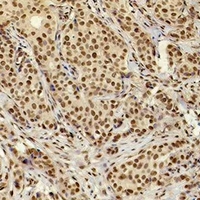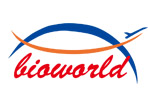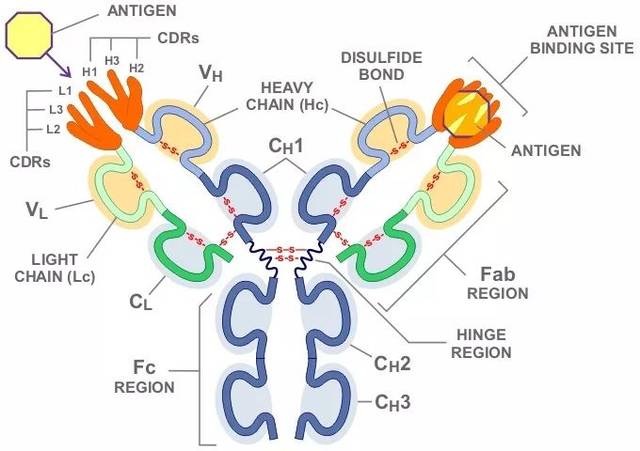Product Name :
XRCC4 monoclonal antibody Background :
DNA double-stranded breaks (DSBs) are potentially hazardous lesions that can be induced by ionizing radiation (IR), radiomimetic chemicals, or DNA replication inhibitors. Cells recognize and repair DSBs via two distinct but partly overlapping signaling pathways, non-homologous end joining (NHEJ) and homologous recombination (HR). DNA repair via the HR pathway is restricted to S and G2 phases of the cell cycle, while NHEJ can occur during any phase. NHEJ machinery is also utilized in V(D)J recombination, a process that generates diversity in immunoglobulin and T cell receptor genes. Defects in both pathways have been associated with human disease, including cancer. DNA repair through the NHEJ pathway involves a core group of proteins that includes the Ku heterodimer (Ku70/Ku80), DNA-PKcs, DNA ligase IV, XRCC4, XLF, and PAXX (PAralog of XRCC4 and XLF, also known as C9orf142 or XLS). XRCC4 interacts with XLF and promotes the ligation of DNA strands by DNA ligase IV. Mutations and polymorphisms in XRCC4 have been linked to human disease, including microcephaly, dwarfism, and cancer susceptibility. Knockdown of XRCC4 expression in hepatocellular carcinoma (HCC) cells and triple-negative breast cancer cells increases sensitivity to doxorubicin and ionizing radiation, respectively. Product :
Liquid in 0.42% Potassium phosphate, 0.87% Sodium chloride, pH 7.3, 30% glycerol, and 0.01% sodium azide. Storage&Stability :
Store at 4°C short term. Aliquot and store at -20°C long term. Avoid freeze-thaw cycles. Specificity :
Recognizes endogenous levels of XRCC4 protein. Immunogen :
KLH-conjugated synthetic peptide encompassing a sequence of human XRCC4. The exact sequence is proprietary. Conjugate :
Unconjugated Modification :
Unmodification
XRCC4 monoclonal antibody Background :
DNA double-stranded breaks (DSBs) are potentially hazardous lesions that can be induced by ionizing radiation (IR), radiomimetic chemicals, or DNA replication inhibitors. Cells recognize and repair DSBs via two distinct but partly overlapping signaling pathways, non-homologous end joining (NHEJ) and homologous recombination (HR). DNA repair via the HR pathway is restricted to S and G2 phases of the cell cycle, while NHEJ can occur during any phase. NHEJ machinery is also utilized in V(D)J recombination, a process that generates diversity in immunoglobulin and T cell receptor genes. Defects in both pathways have been associated with human disease, including cancer. DNA repair through the NHEJ pathway involves a core group of proteins that includes the Ku heterodimer (Ku70/Ku80), DNA-PKcs, DNA ligase IV, XRCC4, XLF, and PAXX (PAralog of XRCC4 and XLF, also known as C9orf142 or XLS). XRCC4 interacts with XLF and promotes the ligation of DNA strands by DNA ligase IV. Mutations and polymorphisms in XRCC4 have been linked to human disease, including microcephaly, dwarfism, and cancer susceptibility. Knockdown of XRCC4 expression in hepatocellular carcinoma (HCC) cells and triple-negative breast cancer cells increases sensitivity to doxorubicin and ionizing radiation, respectively. Product :
Liquid in 0.42% Potassium phosphate, 0.87% Sodium chloride, pH 7.3, 30% glycerol, and 0.01% sodium azide. Storage&Stability :
Store at 4°C short term. Aliquot and store at -20°C long term. Avoid freeze-thaw cycles. Specificity :
Recognizes endogenous levels of XRCC4 protein. Immunogen :
KLH-conjugated synthetic peptide encompassing a sequence of human XRCC4. The exact sequence is proprietary. Conjugate :
Unconjugated Modification :
Unmodification
-
 Western blot analysis of XRCC4 expression in Hela (A), 293T (B) whole cell lysates.
Western blot analysis of XRCC4 expression in Hela (A), 293T (B) whole cell lysates. -
 Immunohistochemical analysis of XRCC4 staining in human breast cancer formalin fixed paraffin embedded tissue section. The section was pre-treated using heat mediated antigen retrieval with sodium citrate buffer (pH 6.0). The section was then incubated with the antibody at room temperature and detected using an HRP conjugated compact polymer system. DAB was used as the chromogen. The section was then counterstained with haematoxylin and mounted with DPX.
Immunohistochemical analysis of XRCC4 staining in human breast cancer formalin fixed paraffin embedded tissue section. The section was pre-treated using heat mediated antigen retrieval with sodium citrate buffer (pH 6.0). The section was then incubated with the antibody at room temperature and detected using an HRP conjugated compact polymer system. DAB was used as the chromogen. The section was then counterstained with haematoxylin and mounted with DPX. -
 Immunohistochemical analysis of XRCC4 staining in human breast cancer formalin fixed paraffin embedded tissue section. The section was pre-treated using heat mediated antigen retrieval with sodium citrate buffer (pH 6.0). The section was then incubated with the antibody at room temperature and detected using an HRP conjugated compact polymer system. DAB was used as the chromogen. The section was then counterstained with haematoxylin and mounted with DPX.
Immunohistochemical analysis of XRCC4 staining in human breast cancer formalin fixed paraffin embedded tissue section. The section was pre-treated using heat mediated antigen retrieval with sodium citrate buffer (pH 6.0). The section was then incubated with the antibody at room temperature and detected using an HRP conjugated compact polymer system. DAB was used as the chromogen. The section was then counterstained with haematoxylin and mounted with DPX.
Bioworld Biotech only provide peptides for our antibodies and do not provide additional peptide customization services.
Price/Size :
USD 368/1mg/vial
Tips:
For phospho antibody, we provide phospho peptide(0.5mg) and non-phospho peptide(0.5mg).Describe :
Blocking peptides are peptides that bind specifically to the target antibody and block antibody binding. These peptide usually contains the epitope recognized by the antibody. Antibodies bound to the blocking peptide no longer bind to the epitope on the target protein. This mechanism is useful when non-specific binding is an issue, for example, in Western blotting (WB) and Immunohistochemistry (IHC). By comparing the staining from the blocked antibody versus the antibody alone, one can see which staining is specific; Specific binding will be absent from the western blot or IHC performed with the neutralized antibody.Formula:
Synthetic peptide was lyophilized with 100% acetonitrile and is supplied as a powder. Reconstitute with 0.1 ml DI water for a final concentration of 10 mg/ml.The purity is >90%,tested by HPLC and MS.
Storage:
The freeze-dried powder is more stable. For short time at 2-8°C. For long term storage store at -20°C.
Note :
This product is for research use only (RUO only). Not for use in diagnostic or therapeutic procedures.
 XRCC4 monoclonal antibody
XRCC4 monoclonal antibody  Datasheet
Datasheet COA
COA MSDS
MSDS SHIP
SHIP